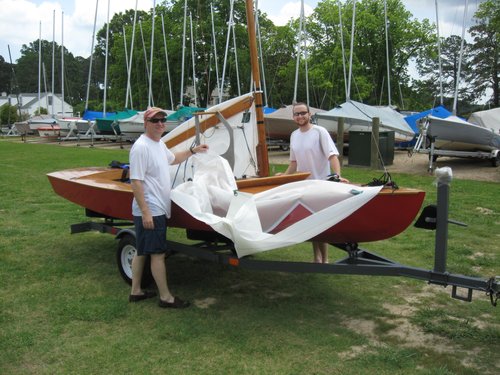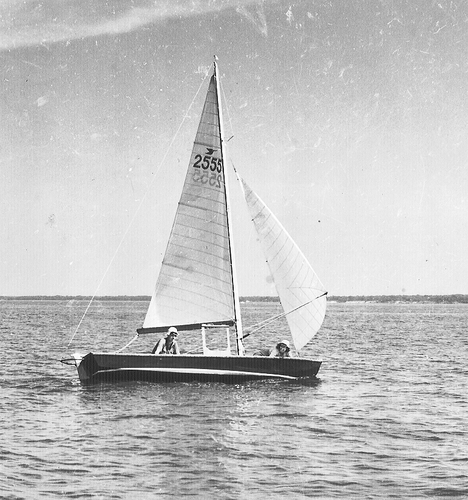FBYC History....
Jere Dennison
Observed earlier this summer by the author: a classic little ‘yacht’ in Fishing Bay, brightwork gleaming in the sun, a fair wooden hull with red-painted topsides. You know the type if you have ever perused the pages of a Wooden Boat magazine…an antique boat afloat that would not have seemed out of place in a museum exhibit.

As I watched intently, she approached the club ramp. Who was the skipper of this stunning craft? I was soon to discover it was member Jim Black with his son as crew. “She is a 1939 Snipe that I restored over 4 years and 1,000 hours,” explained Jim. Pictured here is Snipe #3239 Keep Moving being de-rigged in the parking lot with Jim to left and his son David on the right.
Being club historian, I sensed a story in the making. Coincidentally, 1939 was also the founding year of the Urbanna Yacht Club, our predecessor club, and the Snipe was a major one-design class at UYC during the 1940s, although not surviving the club’s move to Fishing Bay. Reid Dunn, one of the club’s founding members, also owned and campaigned a Snipe. Pictured nearby is Reid’s Snipe # 2555 The Rebel during the Virginia Sailing Regatta hosted by UYC in July 1944. (Note the backstay that more modern rigs do not require. And what a tranquil scene indeed, considering that WWII was raging in Europe and Asia the very moment that this image was captured by a Virginia State Chamber of Commerce photographer!)
The Snipe is a 15 ½ ft. two-man sloop designed in 1931 by magazine editor and naval architect William Cosby. She carried 115 square feet of sail area, displaced 425 lbs., spread a 5 ft. beam, and drew 40” with the board down. Distinguishing features include the high set boom that helps prevent head trauma during unexpected jibes and the lack of a spinnaker which makes it easier to find crew. The class has evolved a little over the years; the minimum weight is now 381 lbs and sail area has increased to 128 sq feet, although other original measurements remain the same.
 Celebrating her 80th year, the Snipe is still one of the most popular one-design classes with over 30,000 worldwide. Not only is she a classic, but her popularity has been steadily increasing. Of course, she entered the fiberglass age decades ago so most of the top sailors are racing plastic versions. Two notable active Snipe sailors, Augie Diaz and Peter Comette, were extraordinary Laser champions in their younger days so this isn’t just a class for juniors or geezers.
Celebrating her 80th year, the Snipe is still one of the most popular one-design classes with over 30,000 worldwide. Not only is she a classic, but her popularity has been steadily increasing. Of course, she entered the fiberglass age decades ago so most of the top sailors are racing plastic versions. Two notable active Snipe sailors, Augie Diaz and Peter Comette, were extraordinary Laser champions in their younger days so this isn’t just a class for juniors or geezers.
I might suggest that, if a group of members wants to consider establishing a competitive fleet of vintage one-designs at the club, then the Snipe might be an ideal candidate as it can be raced by young and old alike.
The incredible story of the provenance, meticulous restoration, and recent racing activities of Jim’s Snipe in his own words:
”Snipe #3239 'Keep Moving' was built in 1939 by a group called the 'Douglas Aircraft Snipe Builders'. According to the unofficial class historian (John Rose of Tacoma Washington), this was a group of guys who built airplanes at Douglas during the day, and built approximately 15 Snipes during their off hours in an unused section of the Douglas plant in Long Beach, mostly between 1939 and 1941.”
“The hull construction is somewhat unusual for a Snipe. The sawn frames and deck beams are fastened with copper rivets rather than screws, and the western red cedar planking is of exceptional quality and size. All planking is quarter sawn, and there is only a single topside and two bottom planks on each side. I believe both of these features are due to the tools and high quality materials that would likely have been available in the aviation industry of the late 1930s.”
“The original owner is unknown, but by the late 1940s the boat was owned by Lloyd Roosevelt of Galveston, Texas. He had the boat measured in Corpus Christi in July 1948, most likely for the class nationals held there that year. I have a suit of cotton sails that may have been used in that regatta
- they were signed by the Galveston fleet measurer in April of the same year.”
“From Galveston the boat went to Thorndale, Texas in the mid 1950s, and then no history is available until the boat was acquired in the early 1980s as a Boy Scout 'fixer-upper' project by the gentleman I got it from. This turned out to be too much of a project for the Boy Scouts to complete, and the boat spent the next 25 years or so under a tarp in a Vienna, VA back yard. I acquired it when the owner moved and needed to get it out of his yard. His son is a friend who knew about both my woodworking and boating disorders.”
“I started the restoration in April 2006, and the boat went back in the water in May 2010. The original tongue and groove cedar deck was beyond repair.
It was replaced with a slightly modernized plywood deck, although three of the original deck beams were reused. The transom was replaced. Most of the screws used in the original construction were plain steel, and had deteriorated badly in the acidic cedar. The frames were refastened to the hull with epoxy and bronze screws, and the 300 or so planking screws were replaced with 'epoxy rivets', where the original iron-sick screw holes were drilled out to 3/8" to get to good wood and filled with quarter inch diameter fiberglass rod and epoxy. The original cotton-caulked plank seams were cleaned out and fastened with epoxy. The outside of the hull has a layer of 6oz fiberglass set in epoxy, and the entire hull inside and out has been encapsulated in epoxy.”
“The mast, rudder, tiller, and daggerboard are not original to the boat.
They came from Snipe #9007, which was built in the early 1950s. They were very kindly given to me by folks at Atlanta Yacht Club while I was there with the partially completed boat for a gathering of wooden Snipes at the Snipe Masters in 2009.”
“So far the boat has been mostly daysailed, although it has been raced in the 2010 FBYC July 4 distance race, the Finger Lakes Boating Museum Wooden Snipe Rally in Geneva NY, the Hampton Roads Sunfish Challenge and Dinghy Distance Race, and the Atlanta Yacht Club Halloween Snipe regatta. With her 60 year old wooden mast and simple sail controls she is not particularly competitive in a modern Snipe fleet. However, she is very stiff and weighs in right at the class minimum. I suspect that with a modern rig and setup she could surprise a lot of people. Maybe someday.”
Jim Black
Addendum:
According to a representative of the SCIRA (Snipe Class International Racing Association), the Urbanna Yacht Club (predecessor to FBYC) evidently had the only Snipe fleet ever chartered in Virginia. Jim Black forwarded the article to the individual at SCIRA with access to Snipe archives and the following was his response in an email dated July 21, 2011:
”Jim, nice article about your restored Snipe #3239 "Keep Moving." I checked the SCIRA Snipe fleet records that I have (hand copied, over 700 fleets at the time) and there was an official SCIRA Snipe fleet at Urbanna, VA - Snipe Fleet #175. It would have dated to about the mid-1940s; it is the only Snipe fleet ever chartered in VA, although there was a Snipe builder there in Norfolk - Laird Boat Corp. (My "home" Snipe fleet in Grand Rapids, MI was Fleet #137, chartered about 1939-41 or thereabouts). Snipe #2555 "Rebel" is reported to be an owner-built boat in 1937 and was measured in 1941. The backstay and daggerboard were racing "extras" that were somewhat uncommon for ordinary Snipes of that era.”
John D. Rose
Tacoma, WA
rosjoh35@comcast.net
Volunteer author - Classic Snipes on SCIRA USA web site http://www.snipeus.org Go to "About Us" and click on prompt "Classic Snipe" for more information